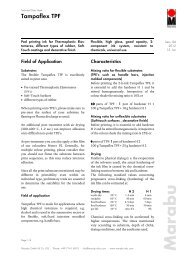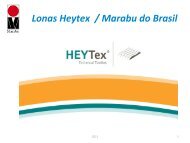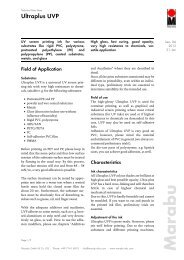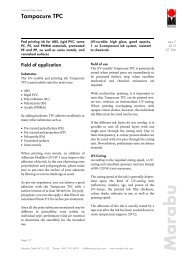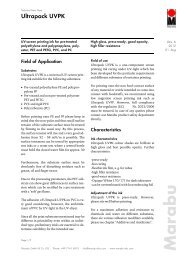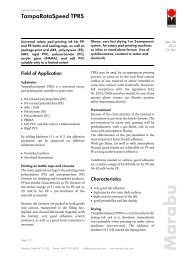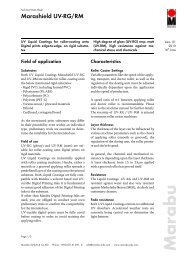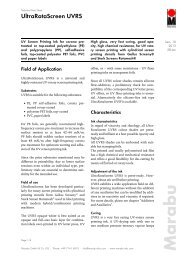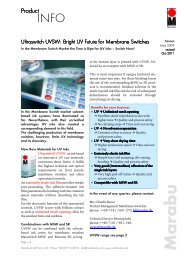Tampastar TPR - Marabu North America
Tampastar TPR - Marabu North America
Tampastar TPR - Marabu North America
Create successful ePaper yourself
Turn your PDF publications into a flip-book with our unique Google optimized e-Paper software.
Technical Data Sheet<br />
<strong>Tampastar</strong> <strong>TPR</strong><br />
Pad printing ink for rigid PVC, polystyrene,<br />
ABS, SAN, polycarbonate, acrylic<br />
glass, and varnished surfaces<br />
Glossy, good opacity, very fast drying,<br />
1- or 2-component system, resistant to<br />
petrol<br />
Vers. 11<br />
2012<br />
13. Dec<br />
Field of Application<br />
Substrates<br />
<strong>Tampastar</strong> <strong>TPR</strong> is particularly suited to print<br />
onto<br />
• Polystyrene (PS)<br />
• ABS / SAN<br />
• Polycarbonate (PC)<br />
• Acrylic (PMMA)<br />
• Rigid PVC<br />
• some types of soft PVC<br />
• Wood, Paper, and cardboard<br />
By adding hardener H 1 or H 2, <strong>Tampastar</strong> <strong>TPR</strong><br />
adheres excellently to many other substrates<br />
such as<br />
• varnished surfaces<br />
• thinly anodized aluminium<br />
• some thermosetting plastics<br />
• Polyacetal (POM)<br />
• Polyamide (PA)<br />
full compliance with the regulation (EC) Nr.<br />
2023/2006 must be ensured. In case of any<br />
queries please contact our <strong>Marabu</strong> product<br />
safety department directly.<br />
Characteristics<br />
Drying<br />
Physically very fast drying. Touch-dry at 20° C<br />
after 60 sec, at 30° C after 15 sec. The addition<br />
of Hardener H 1 or H 2 will extend the drying<br />
time.<br />
The times mentioned vary according to substrate,<br />
depth of cliché, drying conditions, and<br />
the auxiliaries used.<br />
Parallel to physical drying (i. e. to the evaporation<br />
of the solvents used), the actual hardening<br />
of the ink film is caused by the chemical crosslinking<br />
reaction between ink and hardener.<br />
Chemical cross-linking can be accelerated by<br />
higher temperatures.<br />
Since all the print substrates mentioned may be<br />
different in their printability even within an<br />
individual type, preliminary trials are essential<br />
to determine the suitability for the intended<br />
use.<br />
Field of use<br />
The glossy and very fast drying ink <strong>Tampastar</strong><br />
<strong>TPR</strong> is especially suited for high-quality<br />
products such as for example cosmetic<br />
packaging, housings, and other items requiring<br />
high resistance.<br />
<strong>TPR</strong> may be used, by an appropriate printing<br />
process, to print on to the non food-contact<br />
surface of any material or article intended to<br />
come into contact with foodstuffs. However,<br />
Page 1/4<br />
Pot life<br />
The pot life (processing period) at room<br />
temperature (approx. 20 ° C) will be about 12-<br />
14 h with H 1 and about 8-10 h with H 2.<br />
Higher temperatures reduce pot life. If the<br />
mentioned times are exceeded, the ink's<br />
adhesion and resistance may be reduced even if<br />
the ink characteristics show no noticeable<br />
change.<br />
With the use of HT 1, there is no pot life to<br />
consider since this hardener is only activated<br />
by a baking process (30 min/150°C).<br />
The processing and curing temperature should<br />
not be lower than 15° C as irreversible damage<br />
<strong>Marabu</strong> GmbH & Co. KG ⋅ Phone: +49 7141 6910 ⋅ info@marabu-inks.com ⋅ www.marabu-inks.com<br />
<strong>Marabu</strong>
Technical Data Sheet<br />
<strong>Tampastar</strong> <strong>TPR</strong><br />
can occur. Also avoid high humidity for several<br />
hours after printing as the hardener is sensitive<br />
to humidity.<br />
Fade resistance<br />
Only pigments of high fade resistance are used<br />
in the <strong>Tampastar</strong> <strong>TPR</strong> range.<br />
Shades mixed by adding overprint varnish or<br />
other colour shades, and especially white, have<br />
a reduced fade and weather resistance depending<br />
on their mixing ratio. The fade resistance<br />
also decreases if the printed ink film thickness<br />
is reduced.<br />
High-opaque shades<br />
122 Light Yellow<br />
130 Vermilion Red<br />
152 Ultramarine Blue<br />
162 Grass Green<br />
4-colour process shades<br />
429 Process Yellow (Yellow)<br />
439 Process Red (Magenta)<br />
459 Process Blue (Cyan)<br />
489 Process Black (Black)<br />
Press-ready gold and silver shades<br />
191 Silver<br />
192 Rich Pale Gold<br />
193 Rich Gold<br />
The pigments used are resistant to solvents and<br />
plasticizers.<br />
Stress resistance<br />
After proper and thorough drying, the ink film<br />
exhibits outstanding adhesion as well as rub,<br />
scratch, and block resistance and is resistant to<br />
petrol.<br />
In some cases surface stability as well as<br />
adhesion and resistance to solvents may be<br />
improved by adding 10% of Hardener H 1 or H<br />
2.<br />
Range<br />
Basic shades – System Tampacolor<br />
920<br />
922<br />
924<br />
926<br />
930<br />
932<br />
934<br />
936<br />
940<br />
Page 2/4<br />
Lemon<br />
Light Yellow *<br />
Medium Yellow<br />
Orange<br />
Vermilion *<br />
Scarlet Red<br />
Carmine Red<br />
Magenta*<br />
Brown<br />
950<br />
952<br />
954<br />
956<br />
960<br />
962<br />
970<br />
980<br />
(*semi-transparent/transparent)<br />
Further shades available<br />
170 Opaque White<br />
Violet*<br />
Ultramarine Blue*<br />
Medium Blue<br />
Brilliant Blue*<br />
Blue Green<br />
Grass Green *<br />
White, semi-gloss<br />
Black<br />
All shades are intermixable. Mixing with other<br />
ink types or auxiliaries must be avoided in<br />
order to maintain the special characteristics of<br />
this outstanding ink range.<br />
All basic shades are included in our <strong>Marabu</strong>-<br />
ColorFormulator (MCF). They build the basis<br />
for the calculation of individual colour<br />
matching formulas, as well as for shades of the<br />
common colour reference systems HKS ® ,<br />
PAN-TONE ® , and RAL ® . All formulas are<br />
stored in the <strong>Marabu</strong>-Color Manager software.<br />
The high-opaque formulas are additionally<br />
available marked with + + behind the reference<br />
name. These formulas have been developed by<br />
using the System Tampacolor formulas for<br />
basic and high-opaque shades, excluding the<br />
semi-transparent, resp. transparent shades.<br />
The pigments used in the above mentioned<br />
standard shades, based on their chemical<br />
structure, correspond to the EEC regulations<br />
EN 71/part 3, safety of toys - migration of<br />
specific elements. All colours are suited for<br />
printing onto toys.<br />
<strong>Marabu</strong> GmbH & Co.KG ⋅ Phone: +49 7141 6910 ⋅ info@marabu-inks.com ⋅ www.marabu-inks.com<br />
<strong>Marabu</strong>
Technical Data Sheet<br />
<strong>Tampastar</strong> <strong>TPR</strong><br />
Additives<br />
Clears<br />
409 Transparent Base<br />
910 Overprint Varnish, can also be used as bronze<br />
binder<br />
Bronzes<br />
(to be mixed with Overprint Varnish <strong>TPR</strong> 910)<br />
S 181 Aluminium<br />
S 182 Rich Pale Gold<br />
S 183 Rich Gold<br />
S 184 Pale Gold<br />
S 186 Copper<br />
S 190 Aluminium, rub-resistant<br />
TPV 7 is an all-purpose thinner for improved<br />
ink transfer for fast printing. It features good<br />
mixing and solving properties, combined with<br />
a long processing period.<br />
For the printing of very fine motives, Retarder<br />
SV 1 or Retarder Paste VP may be added to the<br />
ink. An excessive addition may result in ink<br />
transfer problems.<br />
By adding Matting Powder MP, the glossy<br />
effect of the ink is reduced to a silky or semimatt<br />
finish. The addition of 2-4% Matting<br />
Powder MP (in the case of 970 White, max.<br />
2%) will not influence significantly the<br />
resistances of the ink but reduce its opacity.<br />
Due to their chemical structure, Pale Gold<br />
S 184 and Copper S 186 have a reduced<br />
processing time. Please generally prepare<br />
mixtures for one working day only as they<br />
cannot be stored and must be processed within<br />
8 h.<br />
Auxiliaries<br />
Thinner:<br />
TPV<br />
TPV 2, fast thinner<br />
TPV 3, slow thinner<br />
TPV 7<br />
Hardener: H 1<br />
H 2, fast hardener<br />
HT 1, heat-reactive<br />
Mixing ratio: 10 p. ink : 1 p. hardener<br />
Retarder: SV 1<br />
VP, Retarder Paste<br />
Matting product: MP, Matting Powder<br />
Antistatic Paste: AP<br />
Opaquing Paste: OP 170<br />
Printing modifier: ES, addition max. 1%<br />
To adjust printing viscosity, it is generally<br />
sufficient to add 10-20% of Thinner TPV to the<br />
ink. Thinner TPV 2 can be used for fast<br />
printing, TPV 3 for slow printing<br />
requirements.<br />
Page 3/4<br />
Attention<br />
For an ink mixture containing retarder, only<br />
thinner should be used for additional thinning<br />
during the print run.<br />
By adding Opaquing Paste 170, the opacity of<br />
colour shades can significantly be increased<br />
without influencing the chemical and dry<br />
abrasion resistance considerably. Maximum<br />
quantity to be added is 15%. OP 170 is not<br />
suitable for using it with white shades.<br />
Printing Modifier ES contains silicone. It can be<br />
used to rectify flow problems on critical<br />
substrates by adding up to 1% by weight to the<br />
ink. If an excessive amount is added, flow<br />
problems are increased and adhesion may be<br />
reduced, especially when overprinting.<br />
Cleaning<br />
For manual cleaning of containers, clichés, and<br />
tools our cleaner UR 3 (flash point 42° C) or<br />
UR 4 (flash point 52°C) can be used.<br />
<strong>Marabu</strong> GmbH & Co.KG ⋅ Phone: +49 7141 6910 ⋅ info@marabu-inks.com ⋅ www.marabu-inks.com<br />
<strong>Marabu</strong>
Technical Data Sheet<br />
<strong>Tampastar</strong> <strong>TPR</strong><br />
Clichés<br />
All commercially available clichés made of<br />
ceramic, photopolymer, thin steel, and chemically<br />
hardened steel (10 mm) can be used. The<br />
recommended cliché depth is 18-21 µm.<br />
Printing pads<br />
As per our experience, all common printing<br />
pads consisting of materials cross-linked by<br />
condensation or addition can be used.<br />
Printing machines<br />
<strong>Tampastar</strong> <strong>TPR</strong> is suitable for closed ink cup<br />
systems, as well as for open ink wells.<br />
Depending on type and usage of the machine,<br />
it is to accordingly adjust type and amount of<br />
the thinner used.<br />
Note<br />
Our technical advice whether spoken, written,<br />
or through test trials corresponds to our<br />
current knowledge to inform about our<br />
products and their use. This is not meant as an<br />
assurance for certain properties of the products<br />
nor their suitability for each application.<br />
You are, therefore, obliged to conduct your<br />
own tests with our supplied products to<br />
confirm their suitability for the desired process<br />
or purpose. The selection and testing of the ink<br />
for specific application is exclusively your<br />
responsibility.<br />
Should, however, any liability claims arise,<br />
they shall be limited to the value of the goods<br />
delivered by us and utilized by you with<br />
respect to any and all damages not caused<br />
intentionally or by gross negligence.<br />
Recommendation<br />
The ink should be stirred well before printing.<br />
To protect the ink in opened containers against<br />
excessive drying, it can be carefully covered<br />
with a layer of thinner which can then be later<br />
stirred into the ink prior to printing.<br />
Labelling<br />
For our ink type <strong>Tampastar</strong> <strong>TPR</strong> and its<br />
additives and auxiliaries, there are current<br />
Material Safety Data Sheets available according<br />
to EC-regulation 1907/2006 informing in<br />
detail about all relevant safety data including<br />
labelling according to the present EEC<br />
regulations as to health and safety labelling<br />
requirements. Such health and safety data may<br />
also be derived from the respective label.<br />
The ink has a flash point between 21° C and<br />
100° C.<br />
Page 4/4<br />
<strong>Marabu</strong> GmbH & Co.KG ⋅ Phone: +49 7141 6910 ⋅ info@marabu-inks.com ⋅ www.marabu-inks.com<br />
<strong>Marabu</strong>



